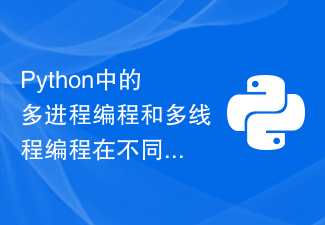 Backend Development
Backend Development Python Tutorial
Python Tutorial Common problems and solution strategies for multi-process programming in Python
Common problems and solution strategies for multi-process programming in Python
Common problems and solution strategies for multi-process programming in Python
Introduction:
With the continuous development of computer hardware, multi-core processors have become more and more more common. In order to make full use of hardware resources and improve program execution efficiency, multi-process programming has become an important technology. But when using multi-process programming, we often encounter some problems, such as inter-process communication, resource synchronization, etc. This article will introduce common problems with multi-process programming in Python, and provide solution strategies and specific code examples.
Question 1: Inter-process communication
Communication between multiple processes is a common problem. In Python's multiprocessing module, a variety of inter-process communication methods are provided, such as pipes (Pipe), queues (Queue) and shared memory (Value, Array). The following is a sample code that uses pipes for inter-process communication:
from multiprocessing import Process, Pipe
def send_data(conn):
data = [1, 2, 3, 4, 5]
conn.send(data)
conn.close()
def receive_data(conn):
data = conn.recv()
print(data)
conn.close()
if __name__ == '__main__':
parent_conn, child_conn = Pipe()
p1 = Process(target=send_data, args=(child_conn,))
p2 = Process(target=receive_data, args=(parent_conn,))
p1.start()
p2.start()
p1.join()
p2.join()In the above code, we create two processes, one process sends data through the pipe, and the other process receives data through the pipe. When communicating between processes, we need to pay attention to the bidirectionality of pipes. Both the parent process and the child process can perform read and write operations, so the sender and receiver of data need to be determined based on actual needs.
Question 2: Process synchronization
Another common problem in multi-process programming is process synchronization. In some cases, we need to ensure that multiple processes execute in a certain order. Python's multiprocessing module provides a variety of process synchronization methods, such as lock, semaphore and event. The following code example shows how to use locks to achieve process synchronization:
from multiprocessing import Process, Lock
def func(lock, counter):
lock.acquire()
try:
for i in range(5):
counter.value += 1
print(counter.value)
finally:
lock.release()
if __name__ == '__main__':
lock = Lock()
counter = Value('i', 0)
processes = []
for i in range(2):
p = Process(target=func, args=(lock, counter))
processes.append(p)
p.start()
for p in processes:
p.join()In the above code, we create a lock object and pass it to two processes. In this way, during process execution, only one process can obtain the lock object, and other processes will wait. This ensures that multiple processes are executed in a certain order.
Question 3: Exception handling in multi-process
In multi-process programming, exception handling is an important issue. If an exception occurs in a process and is not handled, other processes may continue to execute, causing program errors. In order to avoid this situation, we can add exception handling code to each child process and print out the exception. The following example shows how to catch exceptions in multiple processes and print them:
from multiprocessing import Process
def func():
try:
# 子进程需要执行的代码
print('子进程执行')
raise Exception('子进程异常')
except Exception as e:
# 打印异常
print(e)
if __name__ == '__main__':
p = Process(target=func)
p.start()
p.join()In this example, we threw an exception in the child process and handled the exception in the except code block. In this way, even if an exception occurs in the child process, the main process can receive the exception information and handle it in time.
Conclusion:
Multi-process programming in Python provides a large number of tools and methods to help us make full use of hardware resources and improve the execution efficiency of the program. When using multi-process programming, we need to pay attention to issues such as inter-process communication, process synchronization, and exception handling, and use appropriate methods and strategies to solve them. I hope this article can help everyone better understand multi-process programming and successfully apply it to actual projects.
The above is the detailed content of Common problems and solution strategies for multi-process programming in Python. For more information, please follow other related articles on the PHP Chinese website!
 PHP邮件发送方法及常见问题汇总Jun 08, 2023 pm 10:57 PM
PHP邮件发送方法及常见问题汇总Jun 08, 2023 pm 10:57 PM在互联网时代,邮件已经成为人们生活、工作中不可或缺的一个部分。PHP作为一种广泛应用于Web开发领域的语言,邮件发送在Web应用中也是必不可少的。本文将详细介绍PHP邮件发送的相关内容和常见问题汇总。一、PHP邮件发送方法PHPmailer库PHPmailer是一种功能强大的PHP邮件发送类库,它可以轻松地发送HTML格式和纯文本格式的邮件。使用PHPmai
 如何使用 C++ 函数实现多进程编程?Apr 26, 2024 pm 02:21 PM
如何使用 C++ 函数实现多进程编程?Apr 26, 2024 pm 02:21 PMC++中的多进程编程涉及使用头文件创建和管理并行运行的进程。创建进程需要使用std::thread构造函数,并向其传递一个要运行的函数。参数可以通过构造函数作为附加参数传递。一个实战案例演示了使用多进程计算大数字的分解。
 PHP数据分页方法及常见问题详解Jun 09, 2023 am 08:42 AM
PHP数据分页方法及常见问题详解Jun 09, 2023 am 08:42 AM一、前言随着数据处理的不断增多,数据分页成为了一个极其重要的功能。而PHP作为一门广泛应用于Web开发的语言,自然也会有自己的数据分页方法。本文就会对PHP数据分页方法和常见问题进行详细解析。二、PHP数据分页方法1.原始方法数据分页最简单的做法就是使用SQL语句的LIMIT子句,根据每一页需要显示的记录数和当前页码,计算出offset,在查询时添加
 Go语言ORM框架常见问题解析Jun 03, 2023 am 09:22 AM
Go语言ORM框架常见问题解析Jun 03, 2023 am 09:22 AM在现代的Web应用中,使用ORM框架来处理数据库操作已经成为了标配。而在所有的ORM框架中,Go语言ORM框架是越来越受到开发者的关注和喜爱的。然而,当我们使用Go语言ORM框架时,我们可能会遇到一些常见的问题。在本文中,我们将会分析并解决这些常见问题,以便更好地使用Go语言ORM框架。关于GORM的数据模型定义在GORM中,我们可以使用struct定义数据
 Python中的多进程编程和多线程编程在不同场景下的适用性和性能差异是怎样的?Oct 26, 2023 pm 12:49 PM
Python中的多进程编程和多线程编程在不同场景下的适用性和性能差异是怎样的?Oct 26, 2023 pm 12:49 PMPython中的多进程编程和多线程编程在不同场景下的适用性和性能差异是怎样的?在Python中,多进程编程和多线程编程都是为了实现并行计算而存在的。然而,它们在适用性和性能上有一些不同之处。为了更好地理解它们的区别,我们将从适用性和性能两个方面来探讨。适用性方面,多进程编程适用于需要执行CPU密集型任务的场景。这是因为在Python中,由于全局解释器锁(Gl
 Vue组件通讯的常见问题及解决方案Jul 17, 2023 pm 11:16 PM
Vue组件通讯的常见问题及解决方案Jul 17, 2023 pm 11:16 PMVue组件通讯的常见问题及解决方案在Vue应用开发中,组件通讯是一个非常重要的话题。不同组件之间的通讯可以帮助我们实现数据共享、状态管理以及事件传递等功能。然而,组件通讯也常常会遇到一些问题,如何解决这些问题是我们在开发中需要重点关注的。一、父组件向子组件传递数据一种常见的场景是父组件需要将数据传递给子组件。对于这种情况,我们可以使用属性绑定的方式进行传递。
 PHP引入外部文件方法及常见问题解答Jun 09, 2023 pm 04:08 PM
PHP引入外部文件方法及常见问题解答Jun 09, 2023 pm 04:08 PM在使用PHP开发网站或应用程序时,我们通常需要引入一些外部文件以增强功能或优化性能。然而,对于初学者来说,引入外部文件可能会遇到一些问题,因此本文将介绍PHP引入外部文件的方法并解答常见问题。一、PHP引入外部文件的方法include()函数使用include()函数可以将外部文件引入到当前PHP文件中。该函数的语法为:include'外部文件的相对路径或
 ThinkPHP6的常见问题解决办法有哪些?Jun 12, 2023 pm 11:20 PM
ThinkPHP6的常见问题解决办法有哪些?Jun 12, 2023 pm 11:20 PMThinkPHP6是一款广受欢迎的PHP框架,虽然其拥有许多优势和便捷性,但是我们在实际使用中仍然会遭遇一些常见的问题,如果不及时解决这些问题,就有可能阻碍项目的正常进行。本文将介绍一些常见问题的解决办法。1.数据库连接问题在使用ThinkPHP6进行数据库操作时,可能会遭遇无法连接数据库的问题。这时候,我们应该首先检查数据库的配置文件。在config/da


Hot AI Tools

Undresser.AI Undress
AI-powered app for creating realistic nude photos

AI Clothes Remover
Online AI tool for removing clothes from photos.

Undress AI Tool
Undress images for free

Clothoff.io
AI clothes remover

AI Hentai Generator
Generate AI Hentai for free.

Hot Article

Hot Tools

Dreamweaver CS6
Visual web development tools

Dreamweaver Mac version
Visual web development tools

mPDF
mPDF is a PHP library that can generate PDF files from UTF-8 encoded HTML. The original author, Ian Back, wrote mPDF to output PDF files "on the fly" from his website and handle different languages. It is slower than original scripts like HTML2FPDF and produces larger files when using Unicode fonts, but supports CSS styles etc. and has a lot of enhancements. Supports almost all languages, including RTL (Arabic and Hebrew) and CJK (Chinese, Japanese and Korean). Supports nested block-level elements (such as P, DIV),

Notepad++7.3.1
Easy-to-use and free code editor

Zend Studio 13.0.1
Powerful PHP integrated development environment





